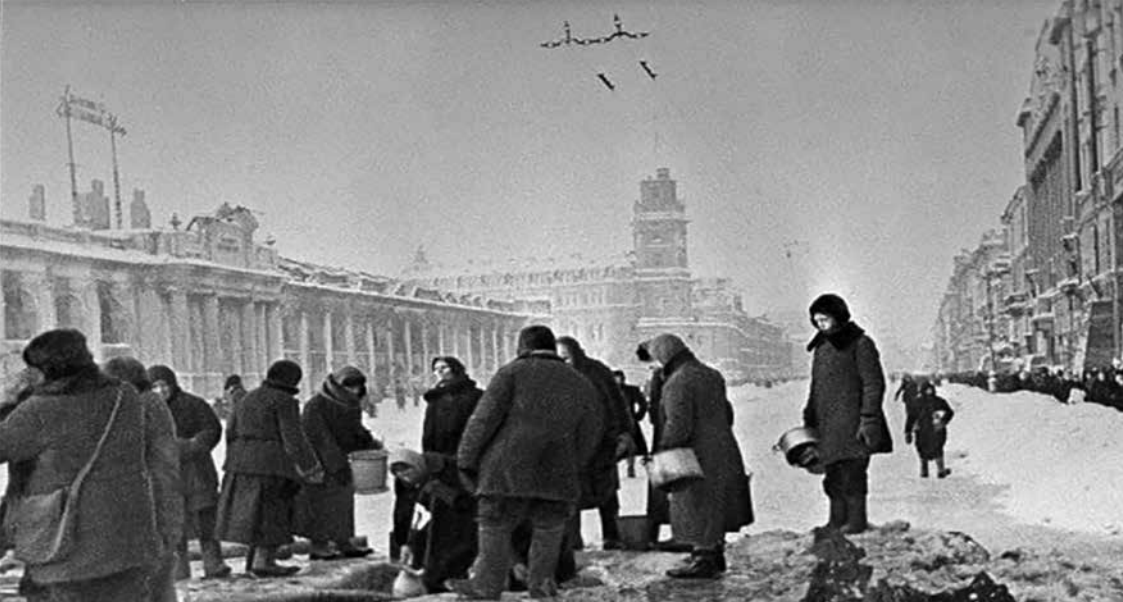
Soviet workers gathering water during the siege
Anti-communist writers depict the resistance to the Nazi siege of Leningrad during World War II as simply an example of workers’ fortitude and courage in the face of extreme suffering and adversity. They say virtually nothing about the role of the Communist Party of the Soviet Union.
This is no accident! After all, the role of the capitalist media and “scholarship” is to provide propaganda for the U.S. bosses. They don’t want workers to learn how communist leadership and ideas were essential to the defeat of the Nazis in World War II and how communist leadership and ideas are needed today to defeat racism, fascism and imperialist wars. As regional wars cover the globe, as world war and climate change threatens the planet, as starvation and a pandemic rage unchecked, capitalism is a failure for the world’s workers. We need communism, where workers run society. The defeat of the Nazis at Leningrad was an example of communist-led workers’ power.
Nazis invade Soviet Union and surround Leningrad
On June 22, 1941, the Nazi army — the most powerful army ever assembled — invaded the Soviet Union. The Nazis and their European allies rapidly surrounded Leningrad. This city of three million was cut off from the rest of the Soviet Union.
Hitler ordered the city of Leningrad and its population to be destroyed. A 900-day siege followed. It resulted in one million deaths and two million other casualties — far more than the combined deaths of the U.S. and Great Britain during the entire war.
Hitler vowed to destroy Leningrad because it was the center of the Bolshevik Revolution. It was named after Vladimir Lenin, the leader of the world communist movement. Hitler figured Leningrad’s destruction would not only be a big military victory, but a huge psychological victory also. The Nazis believed the destruction of the city and its inhabitants would be a blow from which the Soviets could never recover.
Initially, the Nazis amassed massive military strength against the defenders of Leningrad. Enormous bombing and shelling accompanied a tank and troop assault. Daily air attacks and Nazi cannons bombarded every square block of the city every day for two and a-half years.
Communist-led workers fight back
But workers in Leningrad fought on. Despite mass starvation and enormous destruction, they fought back harder. Unlike Paris, Amsterdam and other European cities, Leningrad did not fall! But there was no way supplies could get to the city and little possibility of evacuating children, the old and the ill. Then the leadership of the Communist Party sent in some of its top leaders to strengthen the efforts. A road was built over the frozen Lake Ladoga. Morale increased. Despite the apparently hopeless situation, over a million people, the old and the young were evacuated. Supplies were brought in. The workers and soldiers of Leningrad fought and produced in sub-zero temperatures. Nothing could stop them.
What anti-communist historians and documentaries pointedly omit is that communist ideas and leadership can win workers to unprecedented mass heroism. The workers of Leningrad shed their capitalist ideas and actions. To defeat the Nazis, communist living and fighting was essential. Everyone worked without material rewards. Everyone had to share, so the frontline troops had enough food to be able to fight against the ferocious German attacks. The Communist Party ensured that everyone took part in making decisions. Everyone participated in discussions. Politics was primary. Just as Hitler called for the destruction of Leningrad, the Communist Party, led by Josef Stalin, called on Leningrad not to surrender.
The Communist Party started by organizing small airlifts to drop supplies. Later, the Red Army organized convoys of trucks to transport supplies across frozen Lake Ladoga. Despite constant bombings and huge casualties to drivers, these convoys kept the supplies coming. Under the worst conditions drivers made the round trip again and again, often going for days without sleep.
As the thaw developed, the lake started to melt. But the drivers kept on driving. As the ice melted, water engulfed the trucks above the hubcaps. But the drivers, risking drowning — and some did drown — kept driving. Their efforts were a reflection of the heroism of the city’s inhabitants and of the troops defending the city.
Red Army does the “impossible” — defeats Nazis
Slowly but surely the all-out efforts to supply Leningrad and its defenders started to pay off. Small breakthroughs were made in the ring of steel that the Nazis and their allies had thrown up around Leningrad. Then the Party ordered a rail line built between Moscow and Leningrad. Now the trains started to roll, often only yards away from Nazi gun emplacements. The trains rolled on, despite a rain of shells and bombs, and despite heavy casualties to the train crews.
At last the Red Army was strong enough to launch massive counter-attacks. Then they did the “impossible,” smashing through the Nazi ring of steel and defeating the fascist forces. Leningrad was free! Working class communist determination triumphed over Nazi “supermen.” By the end of the siege, most of the children of Leningrad had been evacuated. Then, the children returned. They were the living future of a city that had been pronounced dead.
The main lesson of Leningrad, and Moscow, and Stalingrad is that when armed with communist ideas and communist leadership, the working class is invincible. No matter how strong the bosses appear, we, the working class, are stronger — IF we act on communist ideas. Workers around the world are not very different from workers in Leningrad. With revolutionary ideas, under revolutionary communist leadership, workers everywhere can make “miracles” too. With world war looming between the imperialists of the U.S., China, Russia and their capitalist allies, the workers of the world must unite and turn these profiteering wars into a worldwide, class war for workers’ power. That’s communism. Join us!
